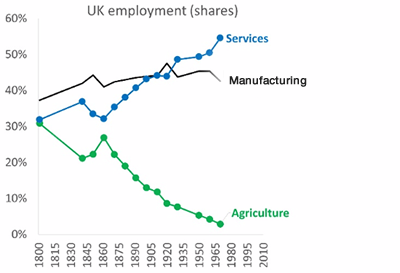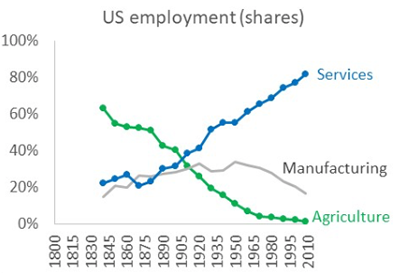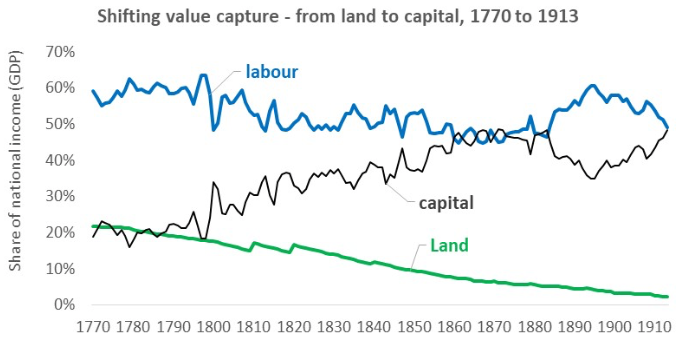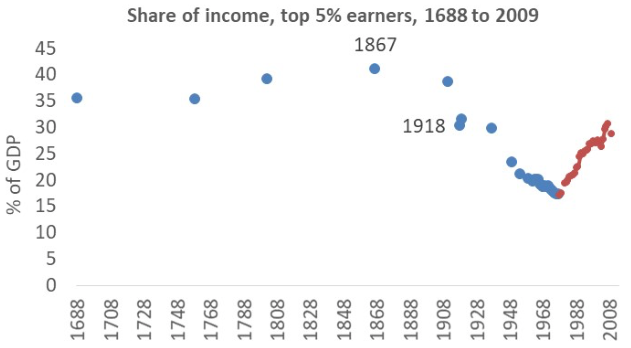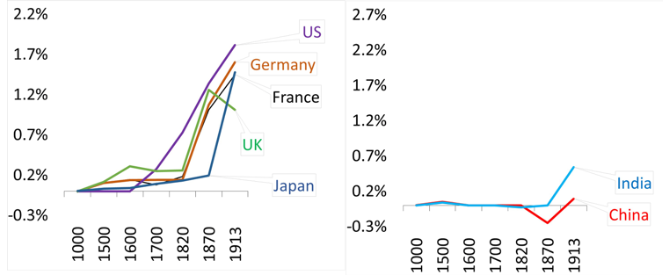Written byRichard Baldwin, Professor of International Economics at The Graduate Institute, Geneva and Founder & Editor-in-Chief of VoxEU.org
The economy appears to be on the cusp of a third great transformation, driven by globalisation and automation. In this post, Richard Baldwin argues that the first step in thinking clearly about the future of work is to look at its historical transformations.
The future of work is a fascinating and important topic – and has been since steam power first got useful in the early 18th century. Since then, economies have struggled through two major economic transformations: when people moved from farms to factories, and when they moved from factories to offices.
Many believe that the economy is on the cusp of a third great transformation – variously called the 'rise of the robots', the 'second machine age', or the '4th industrial revolution' (Brynjolfsson and MacAfee 2014, Ford 2015, Schwab 2016, Bughin et al. 2018). I share this view. Indeed, I think the transformation is coming faster than most believe and in ways few expect. Unlike the last two, the twin engines of this transformation – globalisation and automation – are taking off at the same time. That’s why I like to call it the 'globotics transformation'.
But the first step in thinking clearly about the future of work is to look at the historical transformations of work.
Two historical transformations
Fundamental economic realities have been upended twice in the last three centuries. The first is called the Great Transformation, following the influential work of Karl Polanyi.
The tech impulse behind the Great Transformation was steam power. Steam launched mechanisation (what we’d call automation today) and – a century later – it launched modern globalisation via railroads and steamships. This is when people moved from working on farms to working in factories and from living in the countryside to living in cities. At the same time, the focus of value creation shifted from land to capital.
The Great Transformation was a long, rocky ride that covered two world wars, the Great Depression, and the rise of fascism and communism. After populist leaders like FDR in the US and Clement Attlee in the UK introduced ‘New Deal’ social welfare programmes, the Great Transformation started to be a great thing for the majority.
The facts on the employment shifts are clear in these charts (Herrendorf et al. 2014).
The shift in value creation is clear from this chart (Allen 2018).
The second transformation started in the early 1970s and goes by many names. Early on it was known as the rise of the 'post-industrial society' and later as the 'third industrial revolution' (Rifkin 2011). I think of it as the ‘services transformation’ to distinguish it from the industrial transformation that proceeded it. This transformation was nowhere near as great as the first one. It did, nonetheless, fundamentally change the nature of work by shifting much of the workforce from factories to offices and shifting the focus of value creation from capital to knowledge.
The tech impulse that started the services transformation was computerisation, or what came to be called information and communication technology (ICT). This ICT revolution had two very different effects on the world of work. First, it took the 'man' out of manufacturing by allowing robot ‘hands’ to do things that previously only human hands could. Second, it put powerful tools into the hands of people who worked with their heads, thus massively multiplying their mental ‘muscle’. It allowed office workers to control and process previously unimaginable amounts of information.
Two decades later, ICT launched the ‘New Globalisation’ where firms took their know-how abroad and combined it with low-cost labour in a way that further undermined the fortunes of factory workers in what we used to call the industrialised countries.
This too was a rocky ride, resulting in deindustrialisation of the Global North and a shift to service jobs that was devastating for some and delightful for others. People who worked with their hands found that the technology devalued their value added; people who worked with their heads found the opposite.
But the rocky road was not just about incomes. A general sense of vulnerability and uncertainty spread, since this tech-trade team affected the economy in a very different way than it did before. The changes hit the economy and employment patterns with a finer degree of resolution; it wasn’t sectors and skill groups any more. The changes happened at the level of production stages and even individual jobs. Much of the negative impact was concentrated in particular regions, such as the Rust Belt in the US.
In terms of value creation, intangible investments (i.e. knowledge creation and organisation) outstripped tangible investments in things like machines, buildings, and vehicles (Haskel and Westlake 2017).
Both of these transformations involved massive, complex and tightly interconnected evolutions in economic, political, cultural, geostrategic, and technological factors. To make sense of these in a way that helps us think about the future of work, we need to simplify to clarify.
The transformations as four-step progressions
I argue that the transformations can be thought of as four-step progressions in my 2019 book, The Globotics Upheaval: Globalisation, Robotics and the Future of Work. The progression starts with a technological impulse that triggers an economic transformation (big changes in the pattern of employment, and a shift in the locus of value creation). The economic transformation produces social and economic upheaval (step two). Step three is a backlash of some form, and the last step is some combination of repression, revolution, and reform that constitutes a resolution and establishment of a new economic equilibrium.
These four steps are never clear-cut chronologically, but they follow a socioeconomic and political logic not unlike the 'double movement' that Polanyi used so effectively to characterise the massive changes from the 1700s right up to the 1950s. Each time, automation and globalisation were the twin engines of the transformation and disruption, with automation starting long before globalisation.
Consider how the four steps can help organise our thinking about the complex twists and turns of the Great Transformation.
The Great Transformation, 1712 to 1973
The Great Transformation was triggered by steam power. This first became a part of the economy in 1712, when the Newcomen engine helped drain water out of British coal mines. This was not a technological marvel by today’s standards, but it did open a new chapter in human history – one where humans could bend nature to their will, rather than the other way around. This first use of steam fostered mechanisation – replacing animal, wind, and water power with steam power. The focused and manageable nature of steam power launched a dynamo. Innovation drove industrialisation, industrialisation drove innovation, and both boosted incomes, which, in turn, fostered more innovation and industrialisation.
Although the outcome was a complete revolution in economic affairs and world economic geography, there was nothing fast about the two-century-long tango between industrialisation and globalisation. At first, the technology mostly fostered mechanisation and industrialisation, or what today we’d call automation. The trend started with the biggest industrial sectors of the time – textiles – and soon spread to improved iron and steel working, which led to the rise of factories as a new way of making goods.
Soon enough, the dynamo created a new industry: machine tools. Before the rise of machine tools, industry really meant what today we’d call handicrafts. Production machines were made by hand and mostly of wood. The machine tool industry made it possible to turn out high volumes of machinery made of iron and steel. These new tools, in turn, greatly boosted industrial productivity. Production got faster and cheaper – at least in part because cheaper, less-skilled workers could handle the work. The Ford Motor Company greatly refined the production process a century later in its assembly-line mass production. And the process was cumulative. As mechanical sources of power – steam engines and then diesel, electric, and gasoline engines – got stronger, the machinery got more precise, and this precision helped raise the power of mechanical engines.
One hundred years after having spurred automation, steam engines got small enough and powerful enough to put on wheels and ships. This gave globalisation a mighty boost by dramatically lowering transportation costs. The date to mark for this is 1820, according to economic historians. Railroads and post-Napoleonic peace radically reduced the cost of moving bulk goods, and, for the first time in history, the interiors of Asia, the Americas, and Africa were linked to the global economy. Steamships had an equally radical impact on sea-borne transportation. As reduced transport costs allowed factories to be spatially separated from consumers, mass international trade in goods resulted – what I call the ‘first unbundling’ in my 2006 paper, “Globalisation: The Great Unbundling(s)”.
At first, the Great Transformation led to rising inequality (see the figure below, kindly provided by Max Roser at OurWorldinData.org).
Source: OurWorldInData.org
As the figure shows, the share of income that went to the richest 5% in England and Wales rose gently from about 35% to about 40% between 1688 and 1867. But ultimately, the technology driving the transformation was all about helping people who worked with their hands, not their heads. Since the hand-workers were behind to start with, the Great Transformation was eventually good for social cohesion.
The trend reversed in the late 1800s when the Second Industrial Revolution kicked in. The income share of the top 5% dropped from 40% down to under 20% by the 1970s. Since then it’s been rising, but that’s a story for the next transformation.
Once globalisation got going, industrialisation fostered globalisation, and globalisation spurred industrialisation. Exports lifted the constraint imposed by the size of the domestic market. Selling to the world market encouraged industries to operate on a vast scale. The resulting scale economies, in turn, fostered innovation.
While expanding the market to a planetary size increased the demand for innovation, something very different boosted the supply of innovation. Curiously, as industry moved from small cottages to large factories, production clustered inside advanced-nation factories even as it dispersed internationally. This micro-clustering meant there were lots of people in the same place thinking about similar problems, making innovation easier. And selling to the world market made it more profitable.
The twirling dynamo of the industrialisation-innovation-growth cycle started modern growth. The growth rate that resulted look paltry by today’s standards: per capita growth rates rose from something close to zero in the first half of the 18th century to no more than 2-3% per annum in the mid-1800s. But the bonfire of sustained growth, at any rate, was a revolution in human affairs. It reversed centuries of stagnation. Continual growth opened the door to steady improvements in peoples’ material wellbeing. Growth took off sooner and faster in today's G7 – a difference that eventually created the enormous income differences we see across the world today.
I think of the Great Transformation of the work from farms to factories as lasting from 1712 to the 1970s, when manufacturing employment peaked in the US and UK.
The services transformation, 1973 to 2016
A new technological impulse – one that mainly touched on thoughts, not things – drove the second massive transformation of the global economy: computerisation. Transformations are processes, not events, so all dating of them is artificial but still useful. The year the first computer-on-a-chip was patented, 1973, proves to be a convenient date to mark the beginning of the services transformation and the end of the Great Transformation.
This technology produced a new type of automation in the early 1970s. Twenty years later, computerisation came to include revolutionary changes in communication technology, and so was labelled 'information and communication technology' (ICT, not just IT). This created a new type of globalisation. Being radically different from past technological impulses, this impulse pushed the economy in a radically different direction from the past, as Brynjolfsson and McAfee point out in their brilliant book, The Second Machine Age.
The impact of the ICT impulse was first felt through the automation of industrial jobs. Computer-controlled machines rapidly displaced factory workers as advanced ICT and advanced robot arms took over many of the repetitive, manual tasks that used to require factory workers. By the 1990s, factories in advanced economies were like complex computer systems with robotic peripherals. They were places where people helped machine make things, not the other way around, as was the case previously.
Creating better replacements for factory workers – robots and the like – was a massive job-displacing force that emptied factories in G7 nations faster than the Great Transformation had emptied farms. The impact on factory employment was dramatic. In all advanced economies, the share of jobs in manufacturing has been falling steadily since the 1970s. The US job share of manufacturing fell from 30% in 1970 to 10% in 2010. The trend was the same in all the G7 nations.
The new technology was, by contrast, a massive job-creating force when it came to office workers and professionals. People who worked in occupations requiring the use of their heads rather than their hands found that ICT made them more productive. It created radically more efficient processes for doing all sorts of service-sector tasks. The ease of gathering and manipulating data lowered the price of many services, like design and editing services, which in turn boosted their consumption. It also led to many new products in the service sector. Software became an industry. Telecommunication introduced all sorts of new services and e-commerce was invented. It created millions of new service-sector and professional jobs, many of them in occupations that were previously unimaginable.
This heads-versus-hands impact created a ‘skills twist’, which upgraded the value of mental labour and downgraded the value of manual labour. It created jobs for people who worked mostly with their minds but destroyed jobs for those who worked mostly with their hands. Inequality rose.
From the G7 countries’ social cohesion point of view, the new technology was divisive. Because the ‘head workers’ were already better off than the ‘hand workers’, a technology which favoured brains over brawn favoured the few who were already favoured, while disfavouring the many who weren’t. The resulting deindustrialisation of the G7 economies eventually created enormous social and economic difficulties – first for blue-collar workers, and then for the nations as a whole.
While the first couple of decades of ICT had an enormous impact on automation, from around 1990, ICT came to have enormous effects on globalisation. This globalisation was not like the one that started in the 1800s; a new kind of technological impulse resulted in a new kind of globalisation. This meant that workers in G7 nations were soon competing with low-wage workers abroad who were – via global value chains (GVCs) – using high-technology provided by G7 firms. It was the new movement of technology that made this phase of globalisation so different (as I argue in my 2016 book, The Great Convergence).
International exchanges have always been hindered by the cost of moving goods, ideas, and people across borders. As technology advanced, moving costs for all three fell – but not all at once. Steam power radically reduced transportation costs, and while it also lowered the cost of moving ideas and people as well, it was not in a revolutionary way. The ICT impulse, on the other hand, dramatically lowered the cost of moving ideas – and it did so at an even faster pace than steam had lowered the cost of moving goods.
Moving ideas became cheap and instant, eliminating the need to perform most manufacturing stages inside the same factory or industrial district. The manufacturing micro-clusters – factories and industrial districts – that were so prominent up to the 1980s had been held into these tight clusters by the high cost of long-distance communications, much more than by the high cost of transportation. The ICT revolution changed all that. Drastically improved communications had mammoth implications for the spatial organisation of factories, opening the way for what came to be called ‘offshoring’.
American companies had long understood that they could perform some aspects of the manufacturing process more cheaply abroad. The highly modular nature of the semiconductor production process, for example, allowed US semiconductor producers to put some stages in Asia as early as the 1970s. The barrier to doing this in most industrial sectors was the high costs of coordinating production. That’s why offshoring – the practice of basing some of a company's processes or services overseas – only really took off after ICT made international coordination cheap and reliable. Only then could companies in the US, Germany, and Japan unbundle complex production processes geographically without much loss in quality, timeliness, or reliability.
This new possibility created what I called the ‘New Globalisation’ in my 2016 book (or the 'second unbundling' in my 2006 paper). It allowed manufacturing firms in advanced economies to exploit the vast international wage differences between, for example, the US, Germany, and Japan on one hand, and nearby developing nations like Mexico, Poland, and China on the other. The result was a quite sudden and massive deindustrialisation of the advanced economies.
The third transformation: The rise of ‘globots’
The globotics transformation was launched by digital technology in, say, 2016. It differs from ICT in subtle yet important ways. Oversimplifying to make the point, ICT replaced those who worked with their hands and rewarded those who worked with their heads. Continuing to oversimplify, digitial technology (or 'digitech') is replacing people who work with their heads and rewarding those who work with their hearts.
Tasks that involve routine manipulation of information will be taken over by globots. Globots won’t take over tasks where humanity is an edge or tasks where being in the same room is essential; these tasks will be sheltered from automation and globalisation in the future world of work. The resulting shift into sheltered services and professional jobs will reward a very different set of skills than the skillset that ICT rewarded. Ultimately, artificial intelligence will make everyone a lot smarter in the IQ, pattern-recognition sense of the word 'smart'. The change will be revolutionary for average people, but much less so for the few who are very clever to begin with.
Using 'head' in the sense of 'brain', AI will give more 'head' to people with big hearts, but no extra heart to people with big heads. I think this 21st century skills twist will have unexpected implications for income inequality going forward. Presuming that the distribution of 'heart' skills in the population is basically unrelated to the distribution of 'head' skills, there is no reason that this new skill twist should lead to further rises in income inequality. It might even lower inequality in the long run.
A deep consideration of the globotics transformation is the subject of my next blog post.
The views expressed in this article are those of the authors and do not necessarily reflect the views of UNCTAD.
What must be done to ensure that the potential offered by science, technology and innovation towards achieving the SDGs is ultimately realized?
In the context of the UN Commission on Science and Technology for Development, the CSTD Dialogue brings together leaders and experts to address this question and contribute to rigorous thinking on the opportunities and challenges of STI in several crucial areas including gender equality, food security and poverty reduction.
The conversation continues at the twenty-second session of the CSTD and as an online exchange by thought leaders.


